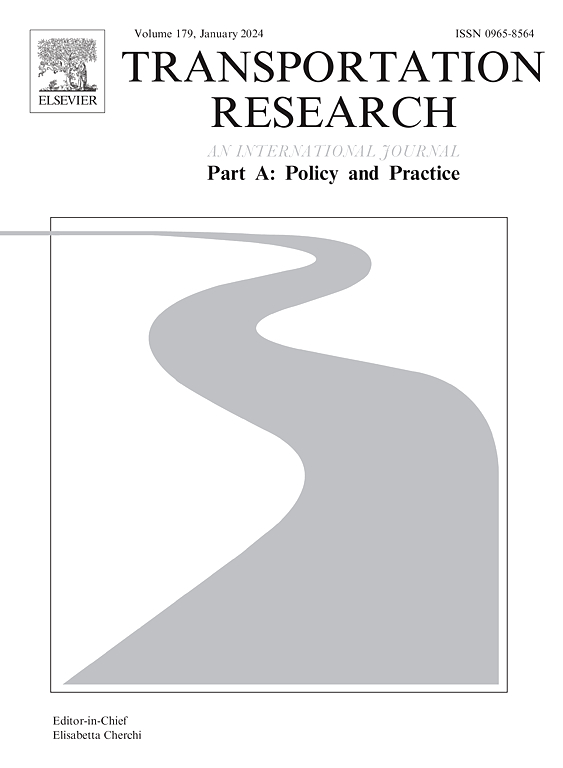感知可达性与空间可达性模型之间的差异:中国广州城市公园案例研究
IF 6.3
1区 工程技术
Q1 ECONOMICS
Transportation Research Part A-Policy and Practice
Pub Date : 2024-11-20
DOI:10.1016/j.tra.2024.104292
引用次数: 0
摘要
根据联合国可持续发展目标,全球各地的倡议都旨在改善城市公园的无障碍环境。然而,准确测量城市公园的空间可达性仍然是一项挑战。传统的测量方法往往无法与居民对可达性的感知相匹配,这凸显了客观测量与主观体验之间的差距。本研究探讨了各种方法得出的公园空间建模可达性(SMA)结果,同时还研究了与居民感知可达性(PPA)之间的差异。我们的研究结果表明,空间分析和居民感知之间存在显著的不一致性,超过 70% 的可达性测量结果存在差异。在不同的 SMA 方法下探索公园的空间分布特征,证实了无障碍建模过程中的地区差异。通过评估各种不同的 SMA 方法,本研究确定了最能反映 PPA 的方法。包含人口偏好和社会人口因素的 SMA 方法提供了更精细的理解,与 PPA 更为接近。特别是,根据与年龄相关的出行时间偏好差异调整的模型能更好地反映居民对交通可达性的看法。该研究强调了选择 SMA 方法的重要性,以及整合与年龄相关的旅行时间偏好来完善城市公园可达性评估的必要性。该研究强调了选择 SMA 方法的重要性,以及结合与年龄相关的旅行时间偏好来完善城市公园可达性评估的必要性,有助于制定更准确、更具包容性的城市规划战略。本文章由计算机程序翻译,如有差异,请以英文原文为准。
Discrepancies between perceived accessibility and spatial accessibility modelling: A case study of urban parks in Guangzhou, China
In line with the United Nation’s Sustainable Development Goals initiatives across the globe aim to improve access to urban parks. It remains, however, a challenge to accurately measure the spatial accessibility of urban parks. Traditional measurements often fail to match residents’ perceptions of accessibility, highlighting a gap between objective measurements and subjective experiences. This study explored the Spatial Modelling Accessibility (SMA) results of parks derived from various approaches, while also examining the differences with Population Perceived Accessibility (PPA).
Our results reveal significant inconsistencies, with over 70 % of accessibility measurements differing between spatial analyses and residents’ perceptions. Exploring spatial distribution features under different SMA approaches for parks confirms the regional differences within the accessibility modelling process. By assessing a diverse array of SMA approaches, this study identifies methods that best reflect PPA. SMA approaches incorporating population preferences and socio-demographic factors offer a more refined understanding, aligning more closely with PPA. Particularly, models adjusted for age related differences in travel time preference better capture residents’ perceptions of accessibility. Integration of population preferences addresses the challenge of defining service radii, a known limitation of traditional models.
The study highlights the important choice of the SMA approach and the need to integrate age related travel time preferences to refine the assessment of urban parks accessibility. It contributes to more accurate and inclusive urban planning strategies.
求助全文
通过发布文献求助,成功后即可免费获取论文全文。
去求助
来源期刊
CiteScore
13.20
自引率
7.80%
发文量
257
审稿时长
9.8 months
期刊介绍:
Transportation Research: Part A contains papers of general interest in all passenger and freight transportation modes: policy analysis, formulation and evaluation; planning; interaction with the political, socioeconomic and physical environment; design, management and evaluation of transportation systems. Topics are approached from any discipline or perspective: economics, engineering, sociology, psychology, etc. Case studies, survey and expository papers are included, as are articles which contribute to unification of the field, or to an understanding of the comparative aspects of different systems. Papers which assess the scope for technological innovation within a social or political framework are also published. The journal is international, and places equal emphasis on the problems of industrialized and non-industrialized regions.
Part A''s aims and scope are complementary to Transportation Research Part B: Methodological, Part C: Emerging Technologies and Part D: Transport and Environment. Part E: Logistics and Transportation Review. Part F: Traffic Psychology and Behaviour. The complete set forms the most cohesive and comprehensive reference of current research in transportation science.

 求助内容:
求助内容: 应助结果提醒方式:
应助结果提醒方式:


